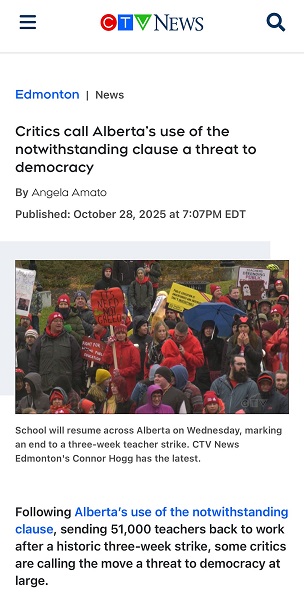Brownstone Institute
Splitting The Difference: Is Partition The Endgame In Canada, U.S.?

[Sign up today for Not The Public Broadcaster newsletters. Hot takes and cool slants on sports and current affairs. Have the latest columns delivered to your mail box. Tell your friends to join, too. Always provocative, always independent. https://share.hsforms.com/16edbhhC3TTKg6jAaRyP7rActsj5 ]
The bumper sticker in Utah is brutally succinct. It shows the donkey image of the Democratic Party with the words, “If you’re going to vote like an ass go back to California.”
You can probably find a similar sentiment, if not bumper sticker, in places like PEI, rural Ontario, Florida, North Carolina, Montana or Texas. The urban elites are fleeing to them from the choked swamp of liberal big cities. They’re looking for lower taxes, lower real estate prices and lower crime rates. But they want to bring their Woke politics with them.

If there’s been one accomplishment of the Biden presidency it has been closing the Woke information loop. Nothing gets into the Progressive Castle to disturb the inhabitants. They listen, but they don’t hear. And their new neighbours want none of it. They don’t want people infected with imported Woke politics infecting their systems.
The latest flash-point example in both nations was the recent SCOTUS decision repealing the sacred liberal signpost of Roe v. Wade. In effect, the justices made no decision on abortion restrictions. They instead stated it was not a matter for the federal government to decide. It should be decided by voters, not judged, in the 50 U.S. states individually.
The Left in both countries predictably went ballistic, claiming SCOTUS overreach. Without reading the decision they insisted that women were again relegated to backrooms and coat hangars. Celebrities and Democrats placeholders made their usual noises to the Media Party about scrapping the Supreme Court or the Constitution if they can’t keep unlimited abortion. Justin Trudeau promised abortion mills for American women seeking to end pregnancies.
What they conveniently hide is that polls in the U.S. show that 37 percent would ban abortion entirely with only rape and incest exceptions, 49 percent support an abortion ban after 6 weeks and 72 percent support abortion ban after 15 weeks. In short the media/ Hollywood consensus— where people like Whoopi Goldberg boast of having seven abortions— represent just 28 percent of those polled. Not that these numbers will ever make it to MSNBC or CBC.
Along with guns, climate change, energy policy, information privacy and higher taxes, the Roe v. Wade fight illustrates the schism that has grown in postmodern society. Where finding compromise and accepting free speech were the bedrock of democratic societies in the U.S. and Canada, today finds warring camps unable and unwilling to agree on any major policy initiatives besides printing more money.
The Supreme Court and the political process are now used to punish opponents. The result? “America is more divided culturally and politically than at any time since the 1850’s. Real and authentic dialogue does not occur, and violence and the threat of violence increase daily. We are on a precarious path with potentially dangerous outcomes.”
Canada is undergoing a similar catharsis, driven by the ideological Justin Trudeau whose fealty to The Great Reset outstrips his interest in gas prices or runaway inflation at home. His attack on privacy and rights— aided by a compliant media— is epitomized by the current persecution of Tamara Lich, the Freedom Convoy coordinator. As a result, weary Canadians are dispersing across the nation to find cities or provinces agreeable to their politics.
The question is, have we reached a point at which citizens, disaffected by their states and provinces, begin moving en masse to entities that suit their politics? Already California is haemorhaging people and companies, with 119,000 citizens leaving the Golden State’s tax rolls in 2021 for places like Utah, Idaho, Texas or Tennessee. The state’s population has now shrunk to 2016 levels, despite the huge flow of illegal migrants into its midst.
In Canada, Toronto’s outward exodus is shielded by the huge influx of immigrants to the GTA. But the real-estate price spikes in smaller communities across the country speaks to the massive outflow of money and talent from the gridlocked city and its unrepentant Boomer values.
With no appetite for compromise from the current governments and their massive bureaucracies could we see something like the exit of the United Empire Loyalists after the American Revolutionary War in the 1780s? Those loyal to the Crown emigrated to pre-Confederation Canada to continue to enjoy the protection of the King. Those supporting the new and untested United States gravitated to the fledgling nation.

In that spirit will we see liberals and progressives who believe in unlimited abortion, gender fluidity, gun seizures, high taxes and draconian climate policies hive in “blue” states while those with contrary opinions gravitate to “red” states such as Texas, Florida, Tennessee or Utah? The re-election of Donald Trump in 2024 would further exacerbate the tensions— and threats— about schism.
In Canada, where provinces have fewer powers than U.S. states in deciding their own policies, could we see a similar schism as the West tries to chart a course different from that of Ontario, Quebec and B.C.’s lower mainland? And if those rejecting the progressive emerging Washington to Ottawa are forcibly made to kneel, surrender guns and acquiesce to state control in their everyday lives could we see violence?

Is it possible that, instead of a relatively peaceful departure of the Loyalists post Revolutionary War, we instead get the partition nightmare experienced by India in 1947. With the British Crown withdrawing from the sub-continent leaving a Hindu India and a new Muslim Pakistan, millions migrated to tribal protections. In the process millions were slaughtered in sectarian fighting.
Today, both possessing atomic weapons, the nations glare menacingly at each other, punctuated by border skirmishes. They remain more isolated than before from the former countryman under the Raj. Driven by idealogues, North America is perched precariously on such a philosophical partition. One that could easily become a physical partition. The Great Compromise of 2022 is waiting by the door, waiting to make its entrance. It will not be a grand entrance.
Bruce Dowbiggin @dowbboy is the editor of Not The Public Broadcaster (http://www.notthepublicbroadcaster.com). The best-selling author was nominated for the BBN Business Book award of 2020 for Personal Account with Tony Comper. A two-time winner of the Gemini Award as Canada’s top television sports broadcaster, he’s also a regular contributor to Sirius XM Canada Talks Ch. 167. His new book with his son Evan Inexact Science: The Six Most Compelling Draft Years In NHL History is now available on http://brucedowbigginbooks.ca/book-personalaccount.aspx
Brownstone Institute
Bizarre Decisions about Nicotine Pouches Lead to the Wrong Products on Shelves

From the Brownstone Institute
A walk through a dozen convenience stores in Montgomery County, Pennsylvania, says a lot about how US nicotine policy actually works. Only about one in eight nicotine-pouch products for sale is legal. The rest are unauthorized—but they’re not all the same. Some are brightly branded, with uncertain ingredients, not approved by any Western regulator, and clearly aimed at impulse buyers. Others—like Sweden’s NOAT—are the opposite: muted, well-made, adult-oriented, and already approved for sale in Europe.
Yet in the United States, NOAT has been told to stop selling. In September 2025, the Food and Drug Administration (FDA) issued the company a warning letter for offering nicotine pouches without marketing authorization. That might make sense if the products were dangerous, but they appear to be among the safest on the market: mild flavors, low nicotine levels, and recyclable paper packaging. In Europe, regulators consider them acceptable. In America, they’re banned. The decision looks, at best, strange—and possibly arbitrary.
What the Market Shows
My October 2025 audit was straightforward. I visited twelve stores and recorded every distinct pouch product visible for sale at the counter. If the item matched one of the twenty ZYN products that the FDA authorized in January, it was counted as legal. Everything else was counted as illegal.
Two of the stores told me they had recently received FDA letters and had already removed most illegal stock. The other ten stores were still dominated by unauthorized products—more than 93 percent of what was on display. Across all twelve locations, about 12 percent of products were legal ZYN, and about 88 percent were not.
The illegal share wasn’t uniform. Many of the unauthorized products were clearly high-nicotine imports with flashy names like Loop, Velo, and Zimo. These products may be fine, but some are probably high in contaminants, and a few often with very high nicotine levels. Others were subdued, plainly meant for adult users. NOAT was a good example of that second group: simple packaging, oat-based filler, restrained flavoring, and branding that makes no effort to look “cool.” It’s the kind of product any regulator serious about harm reduction would welcome.
Enforcement Works
To the FDA’s credit, enforcement does make a difference. The two stores that received official letters quickly pulled their illegal stock. That mirrors the agency’s broader efforts this year: new import alerts to detain unauthorized tobacco products at the border (see also Import Alert 98-06), and hundreds of warning letters to retailers, importers, and distributors.
But effective enforcement can’t solve a supply problem. The list of legal nicotine-pouch products is still extremely short—only a narrow range of ZYN items. Adults who want more variety, or stores that want to meet that demand, inevitably turn to gray-market suppliers. The more limited the legal catalog, the more the illegal market thrives.
Why the NOAT Decision Appears Bizarre
The FDA’s own actions make the situation hard to explain. In January 2025, it authorized twenty ZYN products after finding that they contained far fewer harmful chemicals than cigarettes and could help adult smokers switch. That was progress. But nine months later, the FDA has approved nothing else—while sending a warning letter to NOAT, arguably the least youth-oriented pouch line in the world.
The outcome is bad for legal sellers and public health. ZYN is legal; a handful of clearly risky, high-nicotine imports continue to circulate; and a mild, adult-market brand that meets European safety and labeling rules is banned. Officially, NOAT’s problem is procedural—it lacks a marketing order. But in practical terms, the FDA is punishing the very design choices it claims to value: simplicity, low appeal to minors, and clean ingredients.
This approach also ignores the differences in actual risk. Studies consistently show that nicotine pouches have far fewer toxins than cigarettes and far less variability than many vapes. The biggest pouch concerns are uneven nicotine levels and occasional traces of tobacco-specific nitrosamines, depending on manufacturing quality. The serious contamination issues—heavy metals and inconsistent dosage—belong mostly to disposable vapes, particularly the flood of unregulated imports from China. Treating all “unauthorized” products as equally bad blurs those distinctions and undermines proportional enforcement.
A Better Balance: Enforce Upstream, Widen the Legal Path
My small Montgomery County survey suggests a simple formula for improvement.
First, keep enforcement targeted and focused on suppliers, not just clerks. Warning letters clearly change behavior at the store level, but the biggest impact will come from auditing distributors and importers, and stopping bad shipments before they reach retail shelves.
Second, make compliance easy. A single-page list of authorized nicotine-pouch products—currently the twenty approved ZYN items—should be posted in every store and attached to distributor invoices. Point-of-sale systems can block barcodes for anything not on the list, and retailers could affirm, once a year, that they stock only approved items.
Third, widen the legal lane. The FDA launched a pilot program in September 2025 to speed review of new pouch applications. That program should spell out exactly what evidence is needed—chemical data, toxicology, nicotine release rates, and behavioral studies—and make timely decisions. If products like NOAT meet those standards, they should be authorized quickly. Legal competition among adult-oriented brands will crowd out the sketchy imports far faster than enforcement alone.
The Bottom Line
Enforcement matters, and the data show it works—where it happens. But the legal market is too narrow to protect consumers or encourage innovation. The current regime leaves a few ZYN products as lonely legal islands in a sea of gray-market pouches that range from sensible to reckless.
The FDA’s treatment of NOAT stands out as a case study in inconsistency: a quiet, adult-focused brand approved in Europe yet effectively banned in the US, while flashier and riskier options continue to slip through. That’s not a public-health victory; it’s a missed opportunity.
If the goal is to help adult smokers move to lower-risk products while keeping youth use low, the path forward is clear: enforce smartly, make compliance easy, and give good products a fair shot. Right now, we’re doing the first part well—but failing at the second and third. It’s time to fix that.
Addictions
The War on Commonsense Nicotine Regulation

From the Brownstone Institute
Cigarettes kill nearly half a million Americans each year. Everyone knows it, including the Food and Drug Administration. Yet while the most lethal nicotine product remains on sale in every gas station, the FDA continues to block or delay far safer alternatives.
Nicotine pouches—small, smokeless packets tucked under the lip—deliver nicotine without burning tobacco. They eliminate the tar, carbon monoxide, and carcinogens that make cigarettes so deadly. The logic of harm reduction couldn’t be clearer: if smokers can get nicotine without smoke, millions of lives could be saved.
Sweden has already proven the point. Through widespread use of snus and nicotine pouches, the country has cut daily smoking to about 5 percent, the lowest rate in Europe. Lung-cancer deaths are less than half the continental average. This “Swedish Experience” shows that when adults are given safer options, they switch voluntarily—no prohibition required.
In the United States, however, the FDA’s tobacco division has turned this logic on its head. Since Congress gave it sweeping authority in 2009, the agency has demanded that every new product undergo a Premarket Tobacco Product Application, or PMTA, proving it is “appropriate for the protection of public health.” That sounds reasonable until you see how the process works.
Manufacturers must spend millions on speculative modeling about how their products might affect every segment of society—smokers, nonsmokers, youth, and future generations—before they can even reach the market. Unsurprisingly, almost all PMTAs have been denied or shelved. Reduced-risk products sit in limbo while Marlboros and Newports remain untouched.
Only this January did the agency relent slightly, authorizing 20 ZYN nicotine-pouch products made by Swedish Match, now owned by Philip Morris. The FDA admitted the obvious: “The data show that these specific products are appropriate for the protection of public health.” The toxic-chemical levels were far lower than in cigarettes, and adult smokers were more likely to switch than teens were to start.
The decision should have been a turning point. Instead, it exposed the double standard. Other pouch makers—especially smaller firms from Sweden and the US, such as NOAT—remain locked out of the legal market even when their products meet the same technical standards.
The FDA’s inaction has created a black market dominated by unregulated imports, many from China. According to my own research, roughly 85 percent of pouches now sold in convenience stores are technically illegal.
The agency claims that this heavy-handed approach protects kids. But youth pouch use in the US remains very low—about 1.5 percent of high-school students according to the latest National Youth Tobacco Survey—while nearly 30 million American adults still smoke. Denying safer products to millions of addicted adults because a tiny fraction of teens might experiment is the opposite of public-health logic.
There’s a better path. The FDA should base its decisions on science, not fear. If a product dramatically reduces exposure to harmful chemicals, meets strict packaging and marketing standards, and enforces Tobacco 21 age verification, it should be allowed on the market. Population-level effects can be monitored afterward through real-world data on switching and youth use. That’s how drug and vaccine regulation already works.
Sweden’s evidence shows the results of a pragmatic approach: a near-smoke-free society achieved through consumer choice, not coercion. The FDA’s own approval of ZYN proves that such products can meet its legal standard for protecting public health. The next step is consistency—apply the same rules to everyone.
Combustion, not nicotine, is the killer. Until the FDA acts on that simple truth, it will keep protecting the cigarette industry it was supposed to regulate.
-

 Censorship Industrial Complex2 days ago
Censorship Industrial Complex2 days agoHow the UK and Canada Are Leading the West’s Descent into Digital Authoritarianism
-

 Business2 days ago
Business2 days agoCapital Flight Signals No Confidence In Carney’s Agenda
-

 International2 days ago
International2 days agoThe capital of capitalism elects a socialist mayor
-

 Daily Caller1 day ago
Daily Caller1 day agoUS Eating Canada’s Lunch While Liberals Stall – Trump Admin Announces Record-Shattering Energy Report
-

 Business1 day ago
Business1 day agoCarney’s budget spares tax status of Canadian churches, pro-life groups after backlash
-

 Justice1 day ago
Justice1 day agoCarney government lets Supreme Court decision stand despite outrage over child porn ruling
-

 Business1 day ago
Business1 day agoPulling back the curtain on the Carney government’s first budget
-

 Energy1 day ago
Energy1 day agoEby should put up, shut up, or pay up














